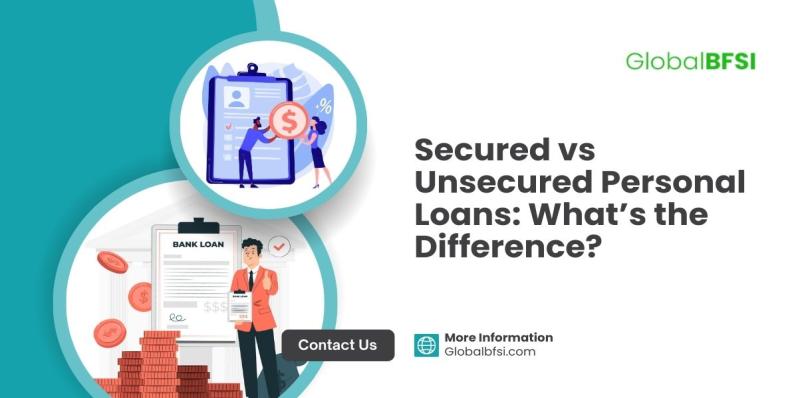- admin's Blog
- Log in or register to post comments

When it comes to personal loans, understanding the difference between secured and unsecured loans is key to making informed financial decisions. Personal loans offer a flexible way to borrow money for various needs, from consolidating debt to financing home improvements. But before taking out a loan, it’s essential to know whether a secured or unsecured option is right for you. This article will break down the main differences between these two types of loans and guide you through the decision-making process.
What is a Secured Personal Loan?
A secured personal loan is one that requires the borrower to offer collateral in exchange for borrowing money. Collateral is an asset, such as a home, car, or savings account, that the lender can claim if the borrower defaults on the loan.
Common types of secured loans include:
- Home equity loans: Leveraging the equity in your home for borrowing.
- Auto loans: Using the purchased vehicle as collateral.
Lenders view secured loans as less risky because the borrower has something of value on the line. As a result, secured loans often come with lower interest rates and higher borrowing limits compared to unsecured loans.
Pros of Secured Loans:
- Lower interest rates: Since the lender has collateral, they typically offer more favorable rates.
- Higher borrowing limits: Borrowers can often secure larger amounts because the lender is protected by the collateral.
Cons of Secured Loans:
- Risk of losing collateral: If you fail to repay the loan, the lender can seize your asset (e.g., your home or car).
- Potentially longer approval process: Secured loans may take longer to approve due to the need to evaluate collateral.
What is an Unsecured Personal Loan?
A personal loan that is not secured is not backed by collateral. In this case, lenders make decisions to lend funds based on the creditworthiness of the borrower, income level, and economic history. Being unsecured by collateral, however, makes the loans riskier for lenders to provide.
Common types of unsecured loans include:
- Personal loans: Borrowed money that can be used for various purposes, such as debt consolidation, medical expenses, or home improvements.
- Credit cards: A revolving line of credit that allows you to borrow and repay money as needed.
Because there’s no collateral involved, unsecured loans often come with higher interest rates and lower borrowing limits compared to secured loans.
Pros of Unsecured Loans:
- No collateral required: There’s no risk of losing an asset if you default on the loan.
- Faster approval: Lenders can often process unsecured loans more quickly since they don’t need to assess collateral.
Cons of Unsecured Loans:
- Higher interest rates: Lenders charge more to offset the lack of collateral, resulting in higher interest rates for borrowers.
- Lower borrowing limits: You may not be able to borrow as much as you would with a secured loan.
Key Differences Between Secured and Unsecured Loans
Understanding the fundamental differences between secured and unsecured loans can help you decide which option suits your needs. Here’s a breakdown:
- Collateral Requirement:
- Secured loans require collateral (e.g., a home or vehicle).
- Unsecured loans don’t require any collateral.
- Risk Level:
- For borrowers, secured loans carry the risk of losing the collateral if they default.
- For lenders, unsecured loans are riskier because there’s no collateral to seize if the borrower fails to repay.
- Interest Rates:
- Secured loans tend to have lower interest rates due to the presence of collateral.
- Unsecured loans generally have higher interest rates due to the increased risk for lenders.
- Loan Amount:
- Secured loans typically offer higher borrowing limits, while unsecured loans come with lower limits.
- Credit Score Impact:
- For unsecured loans, a strong credit score is crucial for getting favorable terms, while secured loans may be more accessible to individuals with lower credit scores because collateral is involved.
Key Considerations for Choosing Between Secured and Unsecured Loans
When deciding between a secured and unsecured loan, consider the following factors:
- Credit Score: If you have a high credit score, you might qualify for better terms on an unsecured loan. If your score is lower, a secured loan may be your best option, as lenders view collateral as a safety net.
- Loan Purpose: The intended use of the loan can help you choose. For example, a secured loan may be ideal for significant expenses like home renovations, while an unsecured loan could be better for consolidating high-interest debt.
- Financial Stability: If you have stable income and assets, you might feel comfortable taking out a secured loan, knowing that you can make timely payments and won’t risk losing your collateral.
- Borrowing Needs: For large expenses or long-term investments, a secured loan may offer the borrowing limit and lower interest rate you need. On the other hand, for smaller, short-term borrowing needs, an unsecured loan might be a quicker, less risky option.
How to Decide Which Loan is Right for You
To decide which type of loan is the best fit for your situation, follow these steps:
- Assess Your Credit Score: Determine how your credit score will impact your loan options. If you have a strong score, you may have more flexibility with unsecured loans.
- Determine the Loan Purpose: Clearly define what you need the loan for. For example, if you need a large sum for home improvements, a secured loan might make more sense. If you’re consolidating smaller debts, an unsecured loan might be sufficient.
- Evaluate Your Risk Tolerance: If you’re uncomfortable with the possibility of losing collateral, an unsecured loan may be the safer option.
- Compare Interest Rates and Terms: Look at the interest rates, terms, and conditions offered by various lenders for both secured and unsecured loans.
Read More:- Personal Loan vs Credit Card Loan: Which One Should You Choose?
